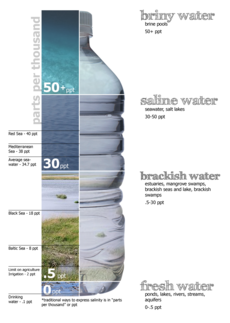
Back Llagu hipersalín AST অতিলোনা হ্রদ Bengali/Bangla Llac hipersalí Catalan Lago hipersalino Spanish دریاچه زیادهشور Persian Lac hypersalin French Lago hipersalino Galician अति-खारी झील Hindi Danau hipersalin ID Lago ipersalino Italian

| Part of a series on |
| Water salinity |
|---|
 |
| Salinity levels |
|
Fresh water (< 0.05%) Brackish water (0.05–3%) Saline water (3–5%) Brine (> 5% up to 26%–28% max) |
| Bodies of water |
A hypersaline lake is a landlocked body of water that contains significant concentrations of sodium chloride, brines, and other salts, with saline levels surpassing that of ocean water (3.5%, i.e. 35 grams per litre or 0.29 pounds per US gallon).
Specific microbial species can thrive in high-salinity environments[1] that are inhospitable to most lifeforms,[2] including some that are thought to contribute to the colour of pink lakes.[3][4] Some of these species enter a dormant state when desiccated, and some species are thought to survive for over 250 million years.[2]
The water of hypersaline lakes has great buoyancy due to its high salt content.[5]
Hypersaline lakes are found on every continent, especially in arid or semi-arid regions.[1]
In the Arctic, the Canadian Devon Ice Cap contains two subglacial lakes that are hypersaline.[6] In Antarctica, there are larger hypersaline water bodies, lakes in the McMurdo Dry Valleys such as Lake Vanda with salinity of over 35% (i.e. 10 times as salty as ocean water).[citation needed]
The most saline water body in the world is the Gaet'ale Pond, located in the Danakil Depression in Afar, Ethiopia. The water of Gaet'ale Pond has a salinity of 43%, making it the saltiest water body on Earth[7] (i.e. 12 times as salty as ocean water). Previously, it was considered that the most saline lake outside of Antarctica was Lake Assal,[8] in Djibouti, which has a salinity of 34.8% (i.e. 10 times as salty as ocean water). Probably the best-known hypersaline lakes are the Dead Sea (34.2% salinity in 2010) and the Great Salt Lake in the state of Utah, US (5–27% variable salinity). The Dead Sea, dividing Israel and the West Bank from Jordan, is the world's deepest hypersaline lake. The Great Salt Lake, while having nearly three times the surface area of the Dead Sea, is shallower and experiences much greater fluctuations in salinity. At its lowest recorded water levels, it approaches 7.7 times the salinity of ocean water, but when its levels are high, its salinity drops to only slightly higher than that of the ocean.[9][10][11]
- ^ a b Cite error: The named reference
Hammer1986was invoked but never defined (see the help page). - ^ a b Cite error: The named reference
Vreelandwas invoked but never defined (see the help page). - ^ Cassella, Carly (13 December 2016). "How an Australian lake turned bubble-gum pink". Australian Geographic. Retrieved 22 January 2022.
- ^ McFadden, Christopher (24 July 2018). "Lake Hillier: Australia's Pink Lake and the Story Behind It". Interesting Engineering. Retrieved 22 January 2022.
- ^ Team, How It Works (2014-04-10). "Can you float in the Great Salt Lake?". How It Works. Retrieved 2020-10-08.
- ^ Muzyka, Kyle (11 April 2018). "Super salty lakes discovered in Canadian Arctic could provide window into life beyond Earth". CBC News. Retrieved 11 April 2018.
- ^ Perez, Eduardo; Chebude, Yonas (April 2017). "Chemical Analysis of Gaet'ale, a Hypersaline Pond in Danakil Depression (Ethiopia): New Record for the Most Saline Water Body on Earth". Aquatic Geochemistry. 23 (2): 109–117. Bibcode:2017AqGeo..23..109P. doi:10.1007/s10498-017-9312-z. S2CID 132715553.
- ^ Cite error: The named reference
Quinn2015was invoked but never defined (see the help page). - ^ Cite error: The named reference
Wilkersonwas invoked but never defined (see the help page). - ^ Cite error: The named reference
Allredwas invoked but never defined (see the help page). - ^ Cite error: The named reference
Kjeldsenwas invoked but never defined (see the help page).
© MMXXIII Rich X Search. We shall prevail. All rights reserved. Rich X Search